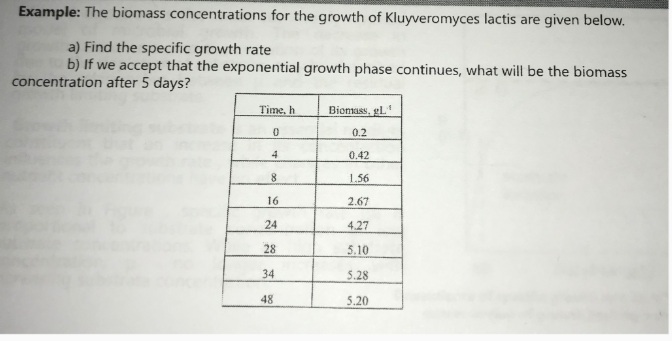To find the specific growth rate (μ), you can use the formula for exponential growth:
\mu = \frac{1}{t} \ln\left(\frac{X_t}{X_0}\right)
Where:
\mu \ \text{is the specific growth rate} \left(h^{-1}\right)
t \ \text{ is the time interval (h),}
X_t \ \text{is the biomass concentration at time t (g/L)}
X_0 \ \text{is the initial biomass concentration.}
\text{Let's calculate } \mu \ \text{using the provided data for the first growth phase (up to t = 48 hours):}
- Select the initial and final biomass concentrations and time interval for the exponential growth phase:
X_0 =0.2 \ \text{g/L} \ (\text{at} \ t = 0 \ \text{hours}),
X_t = 5.2 \ \text{g/L} \ (\text{at}\ t = 48 \ \text{hours}).
- Calculate μ:
\mu = \frac{1}{48-0} \ln\left(\frac{5.2}{0.2}\right)
\mu = \frac{1}{48} \ln(26)
\mu \approx \frac{1}{48} \times 3.2581
\mu \approx 0.0679 \, \text{h}^{-1}
Now, for part (b), if we assume that the exponential growth phase continues, we can use the exponential growth equation to find the biomass concentration after 5 days (t = 120 hours):
X_{\text{final}} = X_0 \times e^{\mu t}
Where:
X_{\text{final}} \ \text{is the biomass concentration after 5 days,}
X_0 = 5.2 \ \text{g/L}
\mu = 0.0679 \ h^{-1}
t = 120 \ \text{hours.}
X_{\text{final}} = 5.2 \times e^{0.0679 \times 120}
X_{\text{final}} \approx 5.2 \times e^{8.148}
X_{\text{final}} \approx 5.2 \times 3334.23
X_{\text{final}} \approx 17400.996 \, \text{g/L}
So, the biomass concentration after 5 days would be approximately 17400.996 g/L if the exponential growth phase continues.
